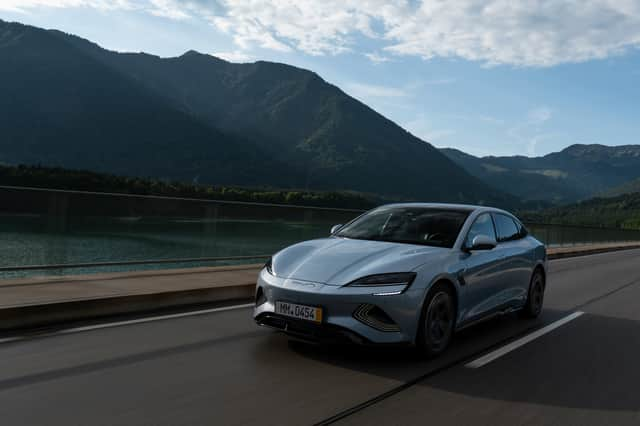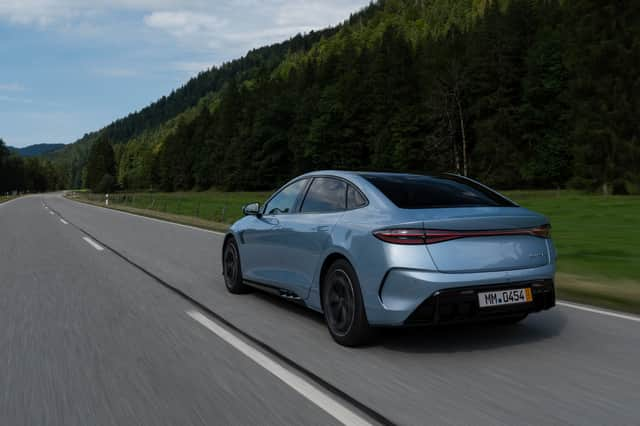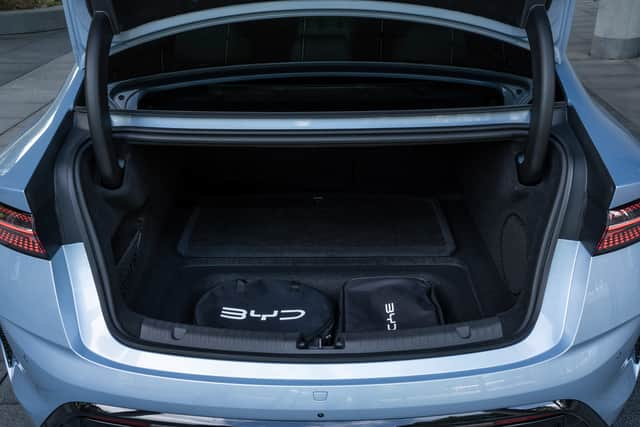BYD Seal review - sleek EV is BYD's best-looking offering yet


We already know how good the BYD EVs are, having driven the Dolphin supermini a couple of months ago. Now the range-topping Seal has arrived as the Chinese carmaker takes the battle to the likes of the Tesla Model 3, the Hyundai Ioniq 6, Kia EV6 and BMW i4.
First-up, the Seal is a pretty good-looking piece of kit. There’s a Porsche Taycan look to the front of the car, and the overall appearance seems to meld the lines of the Tesla 3 and Hyundai Ionia 6 into one combined styling. It’s a handsome and sleek look with a drag coefficient 0.219Cd.
Advertisement
Hide AdAdvertisement
Hide AdFor now, BYD remains one of these car brands most Westerners have never heard of. But the reality is it’s the world’s leading manufacturer of new energy vehicles and power batteries, plus it just happens to build half of the world’s iPads. And following the launch of the Atto 3 SUV and Dolphin into the UK this year, the arrival of the Dolphin is its third new car in 12 months.
Such is the company’s rate of global expansion that BYD claims this Seal saloon is a “next-generation” EV. While the new model sits on the same e-Platform 3.0 used its previous two models, the Seal is BYD’s first British model to make the switch from front to rear-wheel drive. That said, the model I drove was top-spec 4WD Excellence fitted with an additional motor on the front axle.


Immediately there’s a realisation that the “next-generation” billing isn’t just a marketing headline or sound bite. Even at low speeds the newcomer instantly feels more focused, with a firmer, more pliant ride. That’s supplemented by a weightier feel to the steering and, with a new lower driving position, it’s clear the Seal has been designed to be much more driver-oriented than the Atto 3 or Dolphin.
BYD Seal range, price and charge rate
As always with any electric car, there are three main subjects which need addressing: range, charging, and price. So let’s deal with them straight away.
There are two models in the Seal range, the Design and Excellence. The latter, which benefits from four-wheel drive and delivers 523bhp, carries a £3000 premium over the entry-level model which starts at £45,695. But in addition to 4WD, that extra £3k adds some subtle tweaks, including BYD’s Intelligent Torque Adaption Control (iTAC) system — in essence a clever torque-vectoring set-up which reduces slip and increases stability — adaptive dampers and a head-up display.
Worth highlighting here that both the Design and Excellence already come with impressive standard kit including 19in alloys, quilted leather upholstery, a 12-speaker Dynaudio stereo, plus a full-length panoramic roof. And of course, there’s the familiar infotainment system lifted from the Atto 3 and Dolphin, complete with its 15.6-inch rotating display running the same super-fast processor, plus Apple and Android connectivity across the board. There’s a lot of standard tech in the Seal.
Range? The standard two-wheel drive Seal can cover 354 miles from its 82.5kWh battery. Switch up to the Excellence, where the extra front motor adds around 130kg, and range drops to around 323 miles. That’s close to the same as the Tesla Model 3 when it comes to efficiency and range.
As for charging, the BYD Seal has a peak charge rate of 150kW. While that’s slightly down on all its main competitors, it still means a top-up from 30% to 80% can be completed in 26 minutes, which isn’t bad. With the right software, home charging at up to 11kW is possible, but most owners will likely still use a 7kW wallbox to charge overnight.
BYD Seal driving experience
Advertisement
Hide AdAdvertisement
Hide AdWhat’s the Seal like to drive? Based on a test route which included A-roads, town driving, narrow B-roads and motorway, it’s pretty good. Right from the first seconds you set off in the Seal, you can appreciate the improvement in the fact this is a “next generation” BYD.
Throttle response is beautifully balanced and progressive, while the take up is smooth. At all times there’s a reassuring hush inside the well appointed cabin. Steering is quick and well-weighted, allowing the driver to position the car perfectly.
But while there are no steering wheel-mounted paddle controls to control brake regeneration levels — you need to delve into the setting menu — the driver does get the option of a choice of drive modes. My suspicion is most people will stick to Normal, and occasionally flick into Sport … just because you can.
Do the latter and in the Excellence 0-62mph comes round in just 3.8secs. BYD is so proud of the figure they’ve actually badged it ‘BYD Seal 3.8S’ on the bootlid. And the attentive amongst you will have spotted the UK cars have now ditched the legend ‘Build Your Dreams’ — boldly displayed on the rear of the Atto 3 and Dolphin models — from the bootlid of the Seal.
Interior and practicality
Inside, the cabin is dominated by its 15.6in touchscreen, which still manages to pirouette between landscape and portrait: personally, it’s best left in portrait as the alternative does become rather too intrusive and makes the interior look too Tesla-esque. And I’m not sure why — it may have been the reflection from the panoramic sunroof — but in portrait it was almost impossible to read.


Elsewhere in the cabin there’s plenty of premium touches, including a very tactile suede-like material which lines the dash and door cards. In fact, everything your fingers will come into contact with has a quality feel to it. Seats are comfortable and supportive, and there’s plenty of legroom both front and rear. And thanks to the completely flat floor, rear passengers get loads of foot room.
As for bootspace, you can stash 402-litres and family detritus through the slightly narrow opening — I wonder if, in the future, we might get a hatchback version — plus for the first time in a BYD there’s a 53-litre lidded ‘frunk’ under the bonnet; perfect for keeping the charging cables out of the way.
BYD Seal Excellence
Price: £48,695
Powertrain: 82kWh battery pack, three electric motors
Power: 523bhp
Torque: 310Nm
Transmission: Single-speed automatic, all-wheel drive
Top speed / 0-62mph: 112mph / 3.8secs
Range: 323 miles
Charging: 150kW (30-80% in 26min)
Dimensions (length/width/height in mm):n4800/1875/1460mm
On sale: Now
Verdict
So, what’s the verdict? There’s no denying the Seal lifts BYD to another level. Its latest offering is not only the best looking of the three models it’s launched in the UK, but it definitely appeals to the sportier driver, thanks to its sharp handling and steering, and has generous levels of equipment.
Advertisement
Hide AdAdvertisement
Hide AdAt the moment Scotland only has one BYD dealership, which is in Glasgow and sits under the Arnold Clark umbrella. Over the next 12 months, the car giant will expand BYD further with dealerships in Edinburgh, Perth and Aberdeen. There’s no question extending the network will definitely boost the attraction of the badge.
Finally. While the entry-level Design is certainly attractive, starting at £45,695 and with a monthly PCP of £549, it’s difficult to look past the added security of four-wheel drive, better performance and more standard kit in the Excellence, all for an extra 40 quid month.
Comments
Want to join the conversation? Please or to comment on this article.